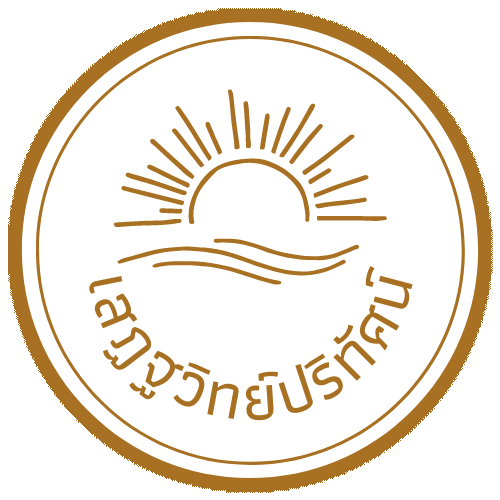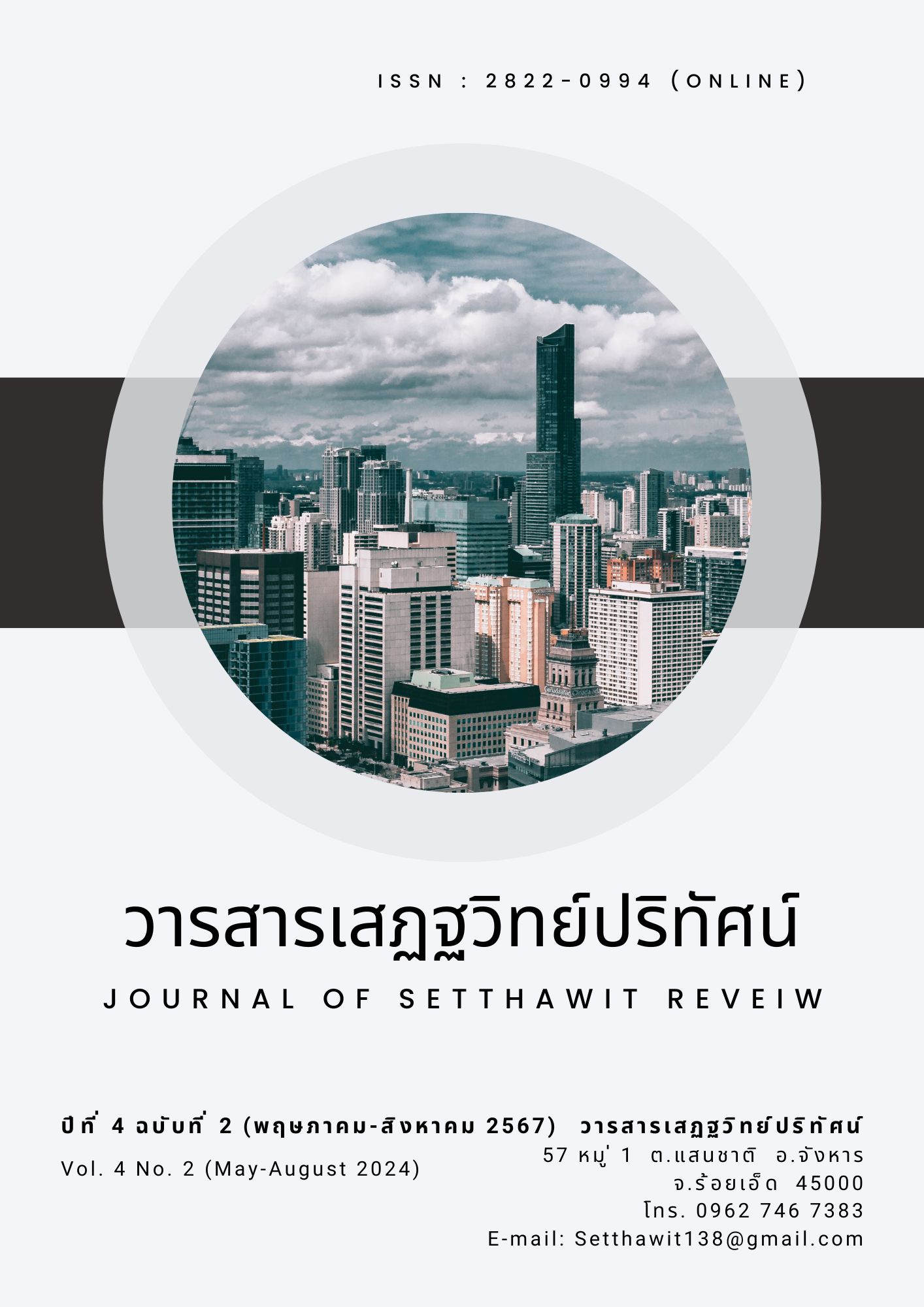Influencing Factors for Production Motivation to Reduce Carbon Footprint Sustainability in the Industrial Factory of Muang Mai Suranaree, Nakhon Ratchasima
Main Article Content
Abstract
The purpose of this research article was to study: (1) the level of motivational factors, production, innovation, and sustainability; (2) factors of production and innovation are the transmission factors between motivation and sustainability; and (3) to present a model of factors that influence sustainability in reducing carbon footprints. In the Suranari New Town Industrial Factory, Nakhon Ratchasima. This research is mixed-method, using a sample of medium- and large-industrial factory entrepreneurs and high-level government executives in the Suranari New City area, Nakhon Ratchasima, with a total of 240 samples. There is a process for creating primary and secondary tools and collecting data. Use an estimation scale to measure accuracy. Confidence was measured by two-step sampling and simple sampling to reiterate the causal model.
The results showed that (1) motivation, production, innovation, and sustainability were all factors with the highest average value, and (2) the subjects analysed were medium and large-scale industrial factory operators and high-level government executives in the Suranari New City area, Nakhon Ratchasima. The harmonicity index values are X2/df = 2.748, RMSEA = 0.064, and RMR = 0.035. (3) medium and large industrial plant operators and high-level government executives in the area. It has the ability to incentivize production to reduce its carbon footprint in a sustainable way. This is considered a highlight of medium and large industrial plant operators and high-level government executives in the Suranari New City area, Nakhon Ratchasima.
Article Details
References
กรมโยธาธิการและผังเมือง. (2564). โครงการแผนแม่บทเมืองใหม่นครราชสีมา. เรียกใช้เมื่อ 19 สิงหาคม 2566 จาก https://office.dpt.go.th/spd/th/general-press-release/9546.
จังหวัดนครราชสีมา. (2564). กฎกระทรวงผังเมืองรวม. เรียกใช้เมื่อ 19 สิงหาคม 2566 จาก https:// data.go.th/organization/dpt-nakhonratchasima.
สำนักนายกรัฐมนตรี. (2564). ถ้อยแถลงต่อที่ประชุมระดับผู้นำในการประชุมรัฐภาคีกรอบอนุสัญญาสหประชาชาติว่าด้วยการเปลี่ยนแปลงสภาพภูมิอากาศ (COP 26). เรียกใช้เมื่อ 19 สิงหาคม 2566 จาก https://www.onep.go.th/2.
สำนักงานอุตสาหกรรมจังหวัดนครราชสีมา. (2566). ข้อมูลและสภาวะอุตสาหกรรมจังหวัดนครราชสีมา ปี 2566. เรียกใช้เมื่อ https://nakhonratchasima.industry.go.th/th.
องค์การบริหารจัดการก๊าซเรือนกระจก. (2554). แนวทางการประเมินคาร์บอนฟุตพริ้นท์ขององค์กร. เรียกใช้เมื่อ 19 สิงหาคม 2566 จาก http://ghginfo.tgo.or.th/index.php/th/?option =com.
Bocken. N. (2014). A Literature and Practice Review to Develop Sustainable Business Model Archetypes. Journal of Cleaner Production, 65, 42-56.
Bevins, D. (2018). Herzberg's Two Factor Theory of Motivation: A Generational Study (Honors Theses). Eastern Kentucky University, Richmond.
COP 26, (2021). COP26: Together for our planet. Accessed January 9, 2023, from https://www.un.org/en/climatechange/cop26.
Fahriana, C., & Sopiah, S. (2022). The Influence of Work Motivation on Employee Performance. Asian Journal of Economics and Business Management, 1(3), 229-233.
Greenpeace. (2023). COP Global Climate Conference. Accessed August 19, 2023, from https://www.greenpeace.org/thailand/explore/protect/climate/cop-conference/?
Joyce, A., & Paquin, L. (2016). The Triple Layered Business Model Canvas: A Tool to Design More Sustainable Business Models. Concordia University. John Molson School of Business, MB.
Lundvall, B. (1985). Product Innovation and User-Producer Interaction. Accessed August 19, 2023, from https://www.semanticscholar.org/paper/Product-Innovation.
Maslow, A. H. (1954). Motivation and Personality. New York: Harper and Bros.
MSCI. (2023). Climate Action Indexes. Accessed August 19, 2023, from https://www. ClimateChange.com/our-solutions/indexes/climate-action-indexes?
Miner, J. B. (2005). Organizational Behavior 1. Essential Theories of Motivation and Leadership. Accessed August 19, 2023, from http://www.MinerJ.B.-_OrganizationalBehaviorI E%20(1).pdf.
Nguyen, T., Nham, T., Froese, F., & Malik, A. (2019). Motivation and Knowledge Sharing: A Meta-Analysis of Main and Moderating Effects. Journal of Knowledge Management. 23(2), 998-1016.
Schmitt, T., Faaland, B., & McKay, M. (2023). Economic Production with Poisson Demand, Lost Sales, Fixed-Rate Discrete Replenishment, And a Constant Setup Time. Production and Operations Management. 32(12), 3968-3985.
Schunk, H., & Usher, E. (2019). Social Cognitive Theory and Motivation. Accessed August 19, 2023, from https://nibmehub.com/opac-service/pdf/read/.
Tobias, W., Herrmann, C., & Thiede, S. (2017). Industry 4.0 Impacts on Lean Production Systems. Procedia Cirp. 63, 125–131.
UNCCD. (2017). Sustainable Land Management Contribution to Successful Land-Based Climate Change Adaptation and Mitigation, a Report Of The Science-Policy Interface. Accessed August 19, 2023, from https://www.unccd.int/sites/default/files/documents/2017-09/UNCCD_Report_SLM_web_v2.pdf.
UNFCCC. (2021). The Glasgow Climate Pact– Key Outcomes from COP26. Accessed August 19, 2023, from https://unfccc.int/process-and-meetings/the-paris-agreement/the-glasgow-climate.
Westland, C. (2010). Lower Bounds on Sample Size in Structural Equation Modeling. Electronic Commerce Research and Applications (Elsevier). 9(6), 476-487.
Yamane, T. (1973). Research Methodology/Sample Size. Florida: University of Florida.
Yin, Y., Stecke, K., & Li, D. (2017). The Evolution of Production Systems from Industry 2.0 Through Industry 4.0. International Journal of Production Research. 56(1-2), 848-861.
Zawadzki, P., & Krzysztof, Z. (2016). Smart Product Design and Production Control for Effective Mass Customization in the Industry 4.0 Concept. Management and Production Engineering Review. 7(3), 105–112.
Zehir, C., Can, E., & Karaboga, T. (2015). Linking Entrepreneurial Orientation to Firm Performance: The Role of Differentiation Strategy and Innovation Performance. Procedia - Social and Behavioral Sciences. 210(2), 358-367.

